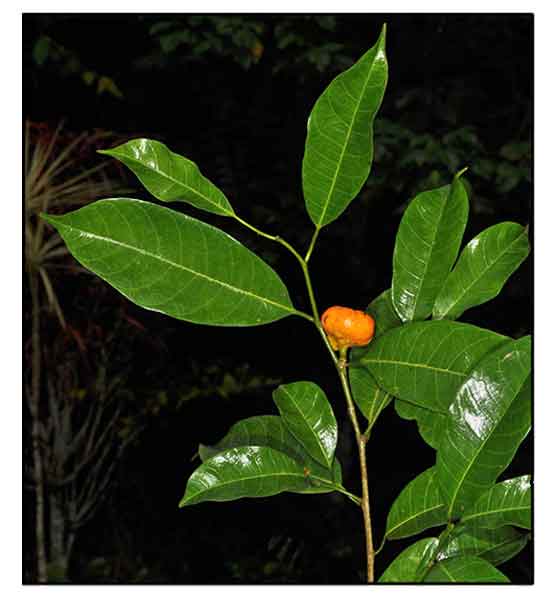 Botany Botany
Artocarpus xanthocarpus is a trees to 8 m tall. Branchlets pale red to ± blackish when young, cylindric, slightly wrinkled, 1.5-3 mm thick, appressed-puberulent, glabrescent. Petiole 0.5-2 cm; leaf blade green, pale brown, or pale green when dry, obovate-elliptic to elliptic-oblong, 5.5-20 × 2.5-9 cm, glabrous, base cuneate to rounded, margin entire, apex acuminate to caudate with a cauda to 3 cm; midvein abaxially prominent, secondary veins 6-11 on each side of midvein and curved, tertiary veins reticulate. Inflorescences axillary, solitary or paired. Male inflorescences globose to obovoid, 3-6 × 3-4 mm; peduncle 2-3 mm, pubescent; bracts small, petiolate, margin ciliate, apically shield-shaped. Female inflorescences capitate; bracts shield-shaped. Male flowers: calyx tubular, apically 2-lobed; filament apically narrowed; anther ellipsoid. Female flowers: style exserted 0.8-1 mm, papillate. Fruiting syncarp yellow when mature, whitish to reddish brown when dry, ± globose, developing into 2 elongated lobes, smooth, glabrous or sparsely tomentose. Calyx and hypocarp adnate and fleshy and enclosing a few drupes; peduncle 6-11 mm, pubescent; bracts few, persistent. Drupes ellipsoid, ca. 4 mm in diam. (Flora of China)
Distribution
- Native to the Philippines.
- Also native to Borneo and Taiwan.
- Grows primarily in the wet tropical biome.
 Constituents Constituents
- Study of A. xanthocarpus isolated 24 compounds, including previously unknown artoxanthocarpuone A, artoxanthocarpuone B, hydroxylakoochin A, methoxylakoochin A, epoxylakoochin A, and artoxanthol. (see study below) (5)
- Study of roots isolated three new compounds, artoxanthocarpuones A-C (1-3), along with 12 known compounds (4-15). (see study below) (6)
Properties
Studies have suggested anticancer, melanin inhibitory properties.
Uses
Edibility
- The genus is an important source of edible fruit. However, there is no report on edibility of Artocarpus xanthocarpus.
Folkloric
- No reported folkloric medicinal use in the Philippines.
Studies
• Melanin Biosynthesis Inhibition / Depigmentation Potential: Study of A. xanthocarpus isolated 24 compounds, including previously unknown artoxanthocarpuone A, artoxanthocarpuone B, hydroxylakoochin A, methoxylakoochin A, epoxylakoochin A, and artoxanthol. Artoxanthol, alboctalol, steppogenin, norartocarpetin, resveratrol, oxyresveratrol, and chlorophorin potently inhibited mushroom tyrosinase activity with IC50 values from 0.9 to 5.7 μM that were all far stronger than the positive controls. Artoxanthocarpuone A, artoxanthocarpuone B, methoxylakoochin A, lakoochin A, cudraflavone C, artonin A, resveratrol, and chlorophorin reduced tyrosinase activity and inhibited α-melanocyte-stimulating hormone-induced melanin production in B16F10 melanoma cells without affecting cell proliferation. Results suggest potential for use as depigmentation agents. (5)
• Melanin Biosynthesis Inhibition / Depigmentation Potential / Roots: Study of roots isolated three new compounds, artoxanthocarpuones A-C (1-3), along with 12 known compounds (4-15). In B16F10 melanoma cells, compound 1, norartocarpetin (4), oxyresveratrol (5), albanin A (8) and steppogenin (9) reduced tyrosinase activity and inhibited α-MSH induced melanin production. Results suggest the isolates with antioxidant and tyrosinase reducing activities have potential as depigmenting agents. (6)
• Lakoochin A / Anticancer / Apoptosis in Malignant Melanoma: Lakoochin A, isolated from Artocarpus xanthocarpus and A. lakoocha, has shown inhibitory effect on tyrosinase activity and melanin production. Study evaluated the therapeutic effects of lakoochin A with apoptosis functions and possible mechanisms on A375.S2 melanoma cells. Lakoochin A attenuated growth of A375.S2 melanoma cells through an apoptosis mechanism. Study demonstrated that lakoochin A, through ROS-MAPK, apoptosis-related proteins, and caspases cascades, can induce melanoma cell apoptosis. Results suggest potential for treatment of malignant melanoma. (7)
Availability
Wild-crafted.
|

![]()





